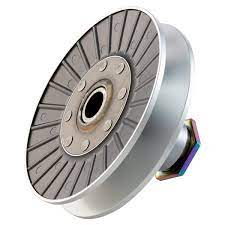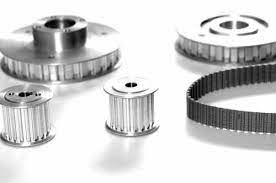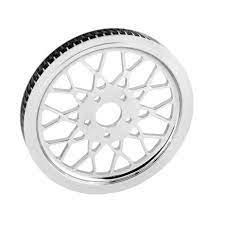Product Description
A conveyor will always consist of at least 2 pulleys, head pulley and tail pulley, with additional pulleys used depending on the configuration. Standard-duty pulleys are usually adequate for simple applications, but mine-duty and engineered pulleys are also available where heavy-duty pulleys are required.
Different kinds of conveyor pulleys
KONWEYOUR sells conveyor pulleys in all the following sub-categories:
Head pulleys
The head pulley is located at the discharge point of the conveyor. It usually drives the conveyor and often has a larger diameter than other pulleys. For better traction, the head pulley is usually lagged (with either rubber or ceramic lagging material).
Tail and CHINAMFG pulleys
The tail pulley is located at the loading end of the belt. It comes with either a flat face or a slatted profile (wing pulley), which cleans the belt by allowing material to fall between the support members.
Snub pulleys
A snub pulley improves the traction of the drive pulley, by increasing its belt wrap angle.
Drive pulleys
Drive pulleys, which can also be the head pulley, are driven by a motor and power transmission unit to propel the belt and material to the discharge.
Bend pulleys
A bend pulley is used for changing the direction of the belt.
Take-up pulley
A take-up pulley is used to provide the belt with the proper amount of tension. Its position is adjustable.
| Type | Belt width(mm) | Standard Diameter(mm) | Length(mm) |
| Drive Pulley | 500 | 500 |
Length of the pulley depends on the belt width of the conveyor |
| 650 | 500~630 | ||
| 800 | 630~1000 | ||
| 1000 | 800~1150 | ||
| 1200 | 800~1150 | ||
| 1400 | 1000~1350 | ||
| 1600 | 1150~1600 | ||
| 1800 | 1150~1800 | ||
| 2000 | 1350~2000 | ||
| 2200 | 1600~2200 | ||
| 2400 | 1800~2400 | ||
| Bend Pully | 500 | 250~500 | |
| 650 | 250~630 | ||
| 800 | 250~1000 | ||
| 1000 | 250~1600 | ||
| 1200 | 250~1600 | ||
| 1400 | 315~1600 | ||
| 1600 | 400~1600 | ||
| 1800 | 400~1600 | ||
| 2000 | 500~1600 | ||
| 2200 | 630~1600 | ||
| 2400 | 800~1600 |
/* January 22, 2571 19:08:37 */!function(){function s(e,r){var a,o={};try{e&&e.split(“,”).forEach(function(e,t){e&&(a=e.match(/(.*?):(.*)$/))&&1
| Material: | Carbon Steel |
|---|---|
| Surface Treatment: | Baking Paint |
| Motor Type: | Frequency Control Motor |
| Customization: |
Available
| Customized Request |
|---|
.shipping-cost-tm .tm-status-off{background: none;padding:0;color: #1470cc}
|
Shipping Cost:
Estimated freight per unit. |
about shipping cost and estimated delivery time. |
|---|
| Payment Method: |
|
|---|---|
|
Initial Payment Full Payment |
| Currency: | US$ |
|---|
| Return&refunds: | You can apply for a refund up to 30 days after receipt of the products. |
|---|
What are some real-world examples of drive pulley applications in various industries?
Drive pulleys find extensive applications in various industries where power transmission and control are essential. They play a critical role in numerous systems that involve the movement of materials, products, or people. Here are some real-world examples of drive pulley applications in different industries:
1. Manufacturing and Industrial:
- Conveyor Systems: Drive pulleys are widely used in manufacturing and industrial settings to power conveyor systems that transport materials or products within factories, warehouses, and distribution centers. These systems are employed in industries such as automotive, food processing, logistics, and packaging.
- Machinery: Drive pulleys are utilized in various types of machinery, including milling machines, lathes, drill presses, and woodworking equipment. They enable the transmission of power to drive the rotational motion of cutting tools or workpieces, allowing for precise machining and fabrication processes.
- Textile Industry: Drive pulleys are found in textile machinery, such as spinning machines and looms, where they provide power transmission to move fibers, yarns, and fabrics through different stages of the manufacturing process.
2. Mining and Quarrying:
- Belt Conveyors: Drive pulleys are extensively used in mining and quarrying operations to power belt conveyors that transport bulk materials, such as coal, ores, aggregates, and minerals. These conveyors are crucial for efficient material handling and are commonly employed in mining sites, quarries, and material processing plants.
- Crushers and Screens: Drive pulleys are utilized in crushers and screens to transmit power and control the movement of materials during the crushing and screening processes in mining and quarrying operations. They enable the efficient processing and sorting of various types of minerals and aggregates.
3. Construction and Infrastructure:
- Concrete Plants: Drive pulleys are used in concrete mixing plants and concrete batching plants to power conveyor belts that transport aggregates, cement, and other materials required for concrete production.
- Escalators and Moving Walkways: Drive pulleys are crucial components in escalators and moving walkways, providing the power and control necessary for the continuous movement of steps or walkway surfaces. These systems are commonly seen in shopping malls, airports, train stations, and other public spaces.
- Cranes and Hoists: Drive pulleys are employed in cranes and hoists to transmit power and control the lifting and lowering of heavy loads in construction sites, warehouses, and shipping ports.
4. Automotive and Transportation:
- Engine Systems: Drive pulleys are used in automotive engines as part of the accessory drive system to transmit power from the engine crankshaft to components such as the alternator, power steering pump, water pump, and air conditioning compressor.
- Power Steering Systems: Drive pulleys are employed in power steering systems to transfer power from the engine to the power steering pump, enabling assisted steering in vehicles.
- Heavy-Duty Trucks and Buses: Drive pulleys are utilized in heavy-duty trucks and buses to transmit power from the engine to various accessories and systems, such as the air compressor, hydraulic pump, and cooling fan.
These examples illustrate the diverse range of industries and applications where drive pulleys are integral components. From manufacturing and mining to construction and automotive sectors, drive pulleys are essential for efficient power transmission, material handling, and control in numerous real-world scenarios.
Can drive pulleys be customized for specific machinery and equipment?
Yes, drive pulleys can be customized to meet the specific requirements of machinery and equipment. Customization allows for the design and manufacturing of drive pulleys that are tailored to suit the unique needs of a particular application. Here are the key aspects of customizing drive pulleys for specific machinery and equipment:
1. Size and Dimension:
Custom drive pulleys can be manufactured in different sizes and dimensions to match the space constraints and installation requirements of the machinery or equipment. The diameter, width, and overall dimensions of the pulley can be adjusted to ensure proper fit and compatibility with the system. Custom sizing ensures that the drive pulley integrates seamlessly into the equipment without any interference or clearance issues.
2. Groove Profile:
The groove profile of the drive pulley is crucial for proper engagement with the belt or chain. Custom drive pulleys can be designed with specific groove profiles to accommodate various belt or chain types, including V-belts, flat belts, round belts, or timing belts. The groove dimensions, angles, and shapes can be customized to ensure optimal belt or chain tracking, reducing the risk of slippage and enhancing power transmission efficiency.
3. Material Selection:
Drive pulleys can be customized with different materials based on the specific requirements of the machinery or equipment. The material selection depends on factors such as load capacity, environmental conditions, and system dynamics. Common materials used for drive pulleys include steel, aluminum, cast iron, or engineered plastics. Customization allows for choosing the most suitable material that offers the desired strength, durability, and corrosion resistance for the application.
4. Shaft Configuration:
Custom drive pulleys can be designed to accommodate specific shaft configurations of the machinery or equipment. The pulley can be manufactured with a keyed bore, tapered bore, or other customized shaft attachment mechanisms to ensure a secure and precise connection. The shaft configuration customization ensures proper alignment and eliminates any potential for slippage or misalignment during operation.
5. Special Features:
Custom drive pulleys can incorporate special features or modifications to meet specific functional requirements. These features can include additional mounting holes, keyways, set screws, or other provisions for auxiliary devices or sensors. Special features can also be added to enhance the performance or functionality of the pulley, such as dynamic balancing for high-speed applications or noise reduction measures.
6. Coatings or Surface Treatments:
Depending on the application and operating conditions, custom drive pulleys can be coated or treated with specialized surface treatments. Coatings such as zinc plating, nickel plating, or powder coating can provide corrosion resistance and improve the aesthetic appearance of the pulley. Surface treatments like heat treatment or hardening can enhance the pulley’s durability, wear resistance, and load-carrying capacity.
7. Performance Optimization:
Custom drive pulleys can be designed and optimized to maximize the performance of the machinery or equipment. Factors such as speed, torque, power requirements, and system dynamics can be taken into account during the customization process. By carefully considering these factors, the drive pulley can be tailored to achieve optimal power transmission efficiency, minimize energy losses, and enhance overall system performance.
In summary, drive pulleys can be customized to suit the specific machinery and equipment requirements. Customization allows for adjusting the size, dimension, groove profile, material selection, shaft configuration, and incorporating special features or coatings. By customizing drive pulleys, manufacturers can ensure seamless integration, optimal performance, and reliable operation in various industrial applications.
How does the size and design of a drive pulley affect its performance?
The size and design of a drive pulley have a significant impact on its performance and the overall operation of a power transmission system. The size and design of a drive pulley influence various aspects such as speed, torque, power transfer efficiency, belt or chain life, and system reliability. Here are the key ways in which the size and design of a drive pulley affect its performance:
1. Speed and Torque:
The size of a drive pulley directly affects the speed and torque of the power transmission system. A larger pulley diameter results in higher belt or chain speed and lower torque output. Conversely, a smaller pulley diameter increases torque output but reduces belt or chain speed. By selecting the appropriate pulley size, the system can be optimized to achieve the desired speed and torque requirements for the driven components.
2. Mechanical Advantage:
The design and size ratio between the driving and driven pulleys determine the mechanical advantage of the power transmission system. By using different-sized pulleys or multiple pulley arrangements, the mechanical advantage can be increased or decreased. This affects the force or torque that can be transmitted from the driving source to the driven components. The mechanical advantage provided by the pulley design influences the system’s ability to handle loads or resistance efficiently.
3. Power Transfer Efficiency:
The design and size of a drive pulley impact the power transfer efficiency of the system. An appropriately sized pulley with the right groove profile facilitates proper belt or chain engagement, reducing slippage and power losses. A well-designed pulley minimizes friction and improves the grip between the pulley and the belt or chain, enhancing power transmission efficiency. Proper pulley design, such as V-grooves or toothed profiles, ensures efficient power transfer and reduces energy losses.
4. Belt or Chain Life:
The size and design of a drive pulley can significantly affect the life and durability of the belt or chain used in the power transmission system. Improper pulley design, such as sharp edges or inadequate groove profiles, can cause premature wear and damage to the belt or chain. Additionally, excessive belt tension resulting from an undersized pulley can lead to accelerated belt wear. Choosing the correct pulley size and design helps optimize belt or chain life, reducing maintenance costs and downtime.
5. Vibration and Noise:
The size and design of a drive pulley can influence the level of vibration and noise in the power transmission system. Improperly designed or unbalanced pulleys can introduce vibration, leading to increased wear and reduced system performance. The design of the pulley, such as the groove profile and the use of vibration-damping materials, can help minimize vibration and noise, ensuring smoother operation and improved system reliability.
6. Belt or Chain Tension and Alignment:
The size and design of a drive pulley affect belt or chain tension and alignment in the power transmission system. An undersized pulley can result in excessive belt or chain tension, leading to increased wear and reduced efficiency. Proper pulley design, including adequate groove width and profile, ensures optimal belt or chain engagement, minimizing tension and alignment issues. This promotes longer belt or chain life and reduces the risk of premature failure.
7. System Compactness and Space Constraints:
The size and design of a drive pulley also play a role in system compactness and space constraints. In applications where space is limited, smaller pulleys may be preferred to achieve the desired speed and torque. Conversely, larger pulleys may be required to accommodate higher power requirements or to optimize the mechanical advantage. The compactness and size of the pulley design should be considered to ensure proper installation and efficient use of available space.
In summary, the size and design of a drive pulley have a significant impact on its performance. They influence speed, torque, power transfer efficiency, belt or chain life, vibration, noise, tension, alignment, and system compactness. Careful consideration of these factors is essential in selecting the appropriate pulley size and design to optimize the performance, reliability, and efficiency of the power transmission system.
editor by CX
2024-03-04




